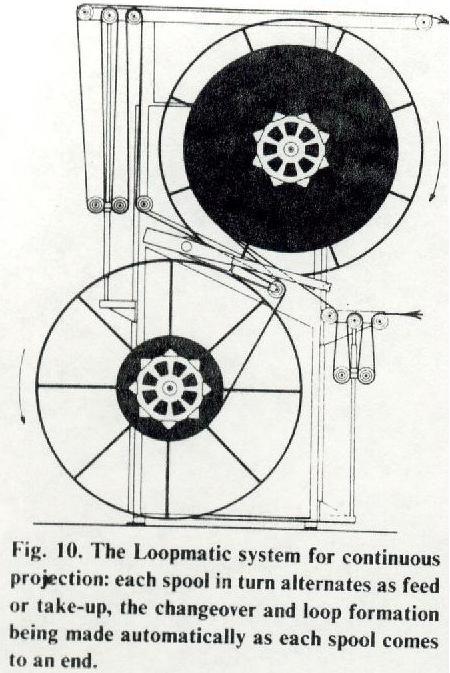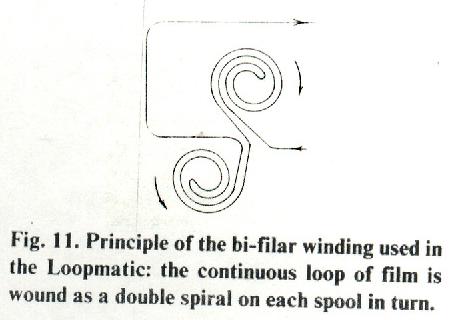|
|
This topic comprises 6 pages: 1 2 3 4 5 6
|
|
Author
|
Topic: Anyone ever seen a XeTron Loop-Matic?
|
Tim Reed
Better Projection Pays

Posts: 5246
From: Northampton, PA
Registered: Sep 1999
|
 posted 05-20-2000 09:51 AM
posted 05-20-2000 09:51 AM




Anyone ever see a Loop-Matic, or have a book on one? This was the bifilar-wound continuous loop system. Very impressive, but I've heard they were too complicated for lowly button-pushers to build prints onto.It was two vertical, open-style reels, placed in the same position as you'd locate a platter. The print was double-wound back on itself, on a reel (like you'd roll-up a sound loop, without breaking the splice apart). One side of the loop fed directly down to the takeup reel and the front half through the machine. Half way through the film, some arms would trip, which would reverse the direction of the reels, and reattach the film to the (now) empty supply reel. Then the second-half of the program finished and the process repeated at the end/beginning of the show. All this time, the projector ran continuously, with no interruption. It was pretty fantastic, from all accounts. I'd love to have seen one in action! I only had a sales sheet on one of these things, but it looked like it'd be the only continuous loop system that would work. Any war stories? ------------------
Better Projection Pays!
| IP: Logged
|
|
|
|
|
|
|
|
|
|
|
|
Tim Reed
Better Projection Pays

Posts: 5246
From: Northampton, PA
Registered: Sep 1999
|
 posted 05-20-2000 10:06 PM
posted 05-20-2000 10:06 PM




I wish I still had the sheet, it had a beautiful picture of both sides of the unit. XeTron (Carbons, Inc.) used to advertise the heck out of it in the early 70s, in Boxoffice. I fell in love with it, but never got to see one.It does not resemble a platter in the least and, Brad, I did not fully understand the operation either, until I took 20-30 ft of film, spliced it in a loop and "tested" it on the bench. It's one of those things that's brilliantly simple. It would even work without fail using the polyester film because, in that respect, it'd be like running it on reels. I did learn that, in order to make-up a print, you first must measure each reel out to the foot. The makeup section holds TWO exchange reels. When you calculate the EXACT center of the movie, begin the makeup there, forming a loop, which is inserted in the center hub of the Loop-Matic reel. Whenever a head or tail is reached, stop and splice the next reel and proceed. You're actually winding onto the Loop-Matic TWO lengths of film, from two different shipping reels, at once. When you're all done, you end-up with the head of reel one and the tail of the last reel, which you then splice together and thread through the machine. Then you're done until the next change of bill. ------------------
Better Projection Pays!
| IP: Logged
|
|
|
|
Christos Mitsakis
Expert Film Handler

Posts: 242
From: Ag.Paraskevi, ATHENS, GREECE
Registered: Sep 1999
|
 posted 05-21-2000 02:44 AM
posted 05-21-2000 02:44 AM




Since I haven't figured out yet how to put images in these posts I sent a scan of the Loopmatic principle to Brad in order to post it here.
It is a scan from SMTE journal Dec 1976
form Bernard Happe presentation of Photokina 76.
I hope you will find it enlighting.I haven't seen one for real but I belive making up a print for
the loopmatic seems to be time consuming. Christos.
| IP: Logged
|
|
Tim Reed
Better Projection Pays

Posts: 5246
From: Northampton, PA
Registered: Sep 1999
|
 posted 05-21-2000 10:23 AM
posted 05-21-2000 10:23 AM




TERRIFIC! Thanks for the info, Christos, I can't wait to see it! Agreed, Scott. It probably wouldn't be a good idea in this day and age, where managers like to play "musical auditoriums" with the prints. But in the late 60s/early 70s, prints would stay for months (or years) sometimes. Of everything I've read about this device (several manufacturers abroad had their own versions), it seems to have Russian origins. Last I heard, it was still used extensively over there. Bring on the diagrams!  ------------------
Better Projection Pays!
| IP: Logged
|
|
|
|
John Walsh
Film God

Posts: 2490
From: Connecticut, USA, Earth, Milky Way
Registered: Oct 1999
|
 posted 05-21-2000 07:41 PM
posted 05-21-2000 07:41 PM




Yeah, I also was interested in this thing. At first I thought it was some platter-like thing I saw many years ago at a SMPTE convention, but that was from Potts (and another tip o' the hat to Gordon's great memory!)Anyway, when Christos mentioned the SMPTE journal it is shown in, I looked it up. It says that it was just distributed by Xetron (then Carbons, Inc.) It was made by Famco AG of Vaduz, Leichtenstein. "The principle is known as bi-filar winding, the looped film being wound as a double-layer spiral on one spool." When the drawing is posted, it's easy to see how it works. It is pretty cool. The article also shows two pictures of projectors with platters mounted directly under the lamp. One was a Philips Kinton FP30, and the other was a Bauer U6.
| IP: Logged
|
|
|
|
|
|
Tim Reed
Better Projection Pays

Posts: 5246
From: Northampton, PA
Registered: Sep 1999
|
 posted 05-24-2000 09:53 PM
posted 05-24-2000 09:53 PM




Beautiful, isn't it?Brad: did you get any other pictures? This says Fig. 10 and 11, like there's at least nine more... I'd like to see how the reel-reversals takes place. ------------------
Better Projection Pays!
|
|
|
|
All times are Central (GMT -6:00)
|
This topic comprises 6 pages: 1 2 3 4 5 6
|
Powered by Infopop Corporation
UBB.classicTM
6.3.1.2
The Film-Tech Forums are designed for various members related to the cinema industry to express their opinions, viewpoints and testimonials on various products, services and events based upon speculation, personal knowledge and factual information through use, therefore all views represented here allow no liability upon the publishers of this web site and the owners of said views assume no liability for any ill will resulting from these postings. The posts made here are for educational as well as entertainment purposes and as such anyone viewing this portion of the website must accept these views as statements of the author of that opinion
and agrees to release the authors from any and all liability.
|

 Home
Home
 Products
Products
 Store
Store
 Forum
Forum
 Warehouse
Warehouse
 Contact Us
Contact Us




 Printer-friendly view of this topic
Printer-friendly view of this topic



















